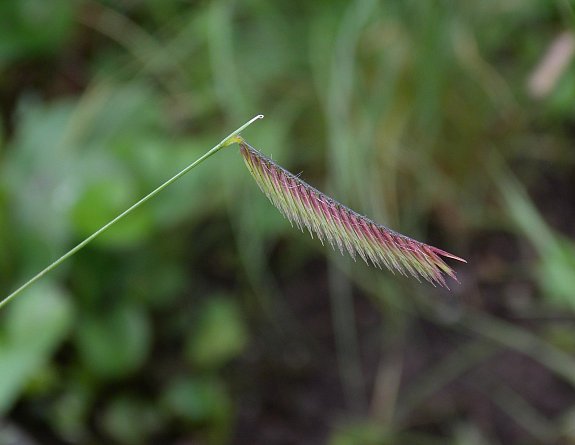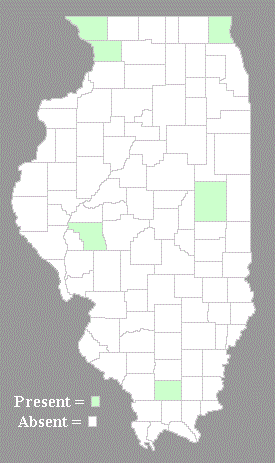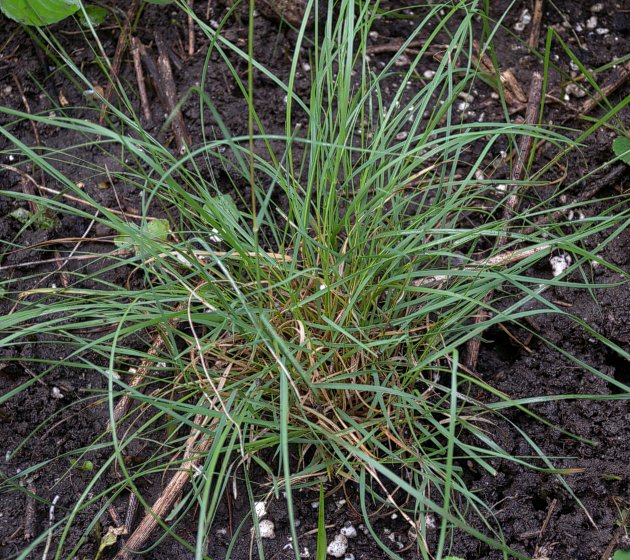
Each culm terminates in 1-3 floral spikes; these spikes are either horizontal or ascending, and they are about 0.75–2" (2–5 cm.) long. Each spike has a rachilla (stalklet) from which 2 rows of floral spikelets hang below. The rachilla of each spike is sparsely hairy and either green, purplish green, or reddish purple; it is straight to slightly curved downward in the middle while it is immature, becoming light tan and more curved as it becomes mature. The rachilla extends beyond the adjacent floral spikelets by 1-6 mm., forming a short spike-like tip. The junction of the rachilla with the culm is hairless (or nearly so). The narrow floral spikelets are 5-7 mm. long and adjacent to each other. Immature spikelets are reddish purple, white, or light green, while mature spikelets are light tan. Each spikelet consists of a pair of glumes, a fertile lemma, and 1-2 aborted sterile lemmas. One glume is 1.5–3 mm. long, while the other glume is 3.5–6 mm. long; both glumes are linear-lanceolate in shape, slightly convex along their outer surfaces, and either smooth, slightly rough-textured, or hairy along their midveins. Between the glumes, there is a fertile lemma about 3.5–6 mm. long; this lemma is linear-lanceolate in shape, short-awned (1-3 mm. long), and hairy at its base. The sterile lemma(s) is 1-3 mm. long, occurring on a short stalk; it is hairy at its base and 3-awned (each awn is 1-3 mm. long). The florets of the fertile
 lemmas bloom intermittently during the summer for about 2-4 weeks; they
are cross-pollinated by the wind. The anthers of the florets are
yellow, while their feathery stigmas are white. At maturity, with the
exception of the persistent glumes, the spikelets detach from the
rachilla. The grains are 2.5–5 mm. long, narrowly ellipsoid in shape,
and flattened along one side. They are blown about by the wind to a
limited extent. The root system is fibrous and abundantly branched,
extending into the ground up to 6 ft. deep. The foliage of this grass
dies down during the winter.
lemmas bloom intermittently during the summer for about 2-4 weeks; they
are cross-pollinated by the wind. The anthers of the florets are
yellow, while their feathery stigmas are white. At maturity, with the
exception of the persistent glumes, the spikelets detach from the
rachilla. The grains are 2.5–5 mm. long, narrowly ellipsoid in shape,
and flattened along one side. They are blown about by the wind to a
limited extent. The root system is fibrous and abundantly branched,
extending into the ground up to 6 ft. deep. The foliage of this grass
dies down during the winter.Cultivation: The preference is full sun, dry-mesic to dry conditions, and sterile soil containing clay, gravel, or sand. Strongly acidic soil is not tolerated. Drought tolerance is excellent, but competition from taller plants is limited. Northern ecotypes of this grass are very winter-hardy; it is also tolerates high summer temperatures. Because of the C4 metabolism of this grass, most growth and development occurs during warm summer weather. This grass spreads slowly, forming dense tufts of leaves when it isn't crowded. Under crowded conditions, it will form a sod that is suitable for grassy lawns in sunny areas.
Range & Habitat: Blue Grama (Bouteloua gracilis) is regarded as a native plant in NW Illinois, while in the rest of the state it is adventive. Overall, it is rare within the state, occurring in widely scattered counties. The primary range of this grass occurs in the short-grass prairie of the Great Plains. In Illinois, there are only small remnant populations. Habitats include sandy hill prairies, loess hill prairies, gravel hill prairies, sand prairies, gravelly areas along railroads, and mined land. In Illinois, this grass occurs in both high quality natural areas and disturbed areas where exposed barren ground is dry and sunny.
Faunal Associations: The larvae of two skippers, Hesperia leonardus (Leonard's Skipper) and Hesperia ottoe (Ottoe's Skipper), have been observed to feed on this grass (Robinson et al., 2010). In addition, a mealybug that is found in the Great Plains (although not Illinois), Antoninoides boutelouae, feeds at the base of its culms (ScaleNet, 2014). A large number of grasshoppers feed on both the foliage and inflorescences of this grass (see Grasshopper Table). This includes such species as Ageneotettix deorum (White-whiskered Grasshopper), Eritettix simplex (Velvet-striped Grasshopper), Hippiscus ocelote (Wrinkled Grasshopper), and Trachyrhachys kiowa (Kiowa Grasshopper). Most of these observations have occurred in the Great Plains region. Among vertebrate animals, this grass is a major source of food for the American Bison in the short-grass prairie. Other animals, such as Mule Deer, rabbits, and rodents, reportedly feed on either the foliage or seeds, but these observations have occurred in the Great Plains region and areas further to the west. The awns of the floral spikelets may cling to the fur of passing mammals or the feathers of birds, spreading the seeds of this grass to new areas.

Photographic Location: A wildflower garden in Urbana, Illinois.
Comments: Blue Grama (Bouteloua gracilis) is an attractive grass, especially during the summer when it is actively growing and producing its inflorescences. The floral spikes are very distinctive and at times rather colorful, superficially resembling short brushes or bushy eyebrows. In Illinois, it is difficult to confuse Blue Grama with any other grass, with the exception of the closely related Hairy Grama (Bouteloua hirsuta). This latter grass has hairier floral spikes; both its rachilla (stalklet) and floral spikelets are more hairy in appearance than those of Blue Grama. The junction of its rachilla and its culm is also quite hairy, and Hairy Grama usually produces red anthers, rather than yellow. This latter grass is native to western and northern Illinois, where it prefers sandy habitats that are sunny and dry.